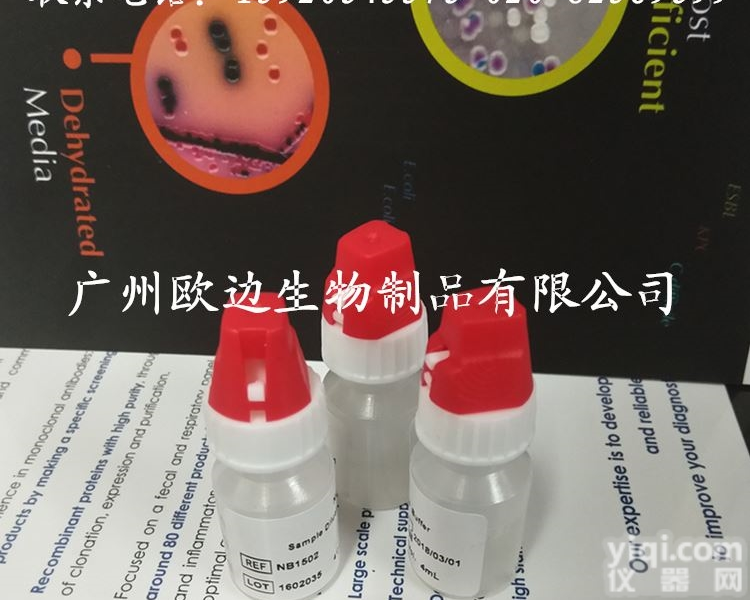Myosin,Smooth Muscle 肌球蛋白重链
广州健仑生物科技有限公司
平滑肌肌球蛋白重链是分子量为200kDa 的多肽,是六聚肌球蛋白的结构成分。主要用于研究血管和内脏平滑肌细胞以及肌上皮细胞,被认为是平滑肌较为特异和可靠的参考依据,有助于间叶肿瘤的研究和分类,也可用于乳腺肌上皮细胞的检测,有助于原位癌和浸润癌的区别研究。
我司还提供其它进口或国产试剂盒:登革热、疟疾、流感、A链球菌、合胞病毒、腮病毒、乙脑、寨卡、黄热病、基孔肯雅热、克锥虫病、违禁品滥用、肺炎球菌、军团菌、化妆品检测、食品安全检测等试剂盒以及日本生研细菌分型诊断血清、德国SiFin诊断血清、丹麦SSI诊断血清等产品。
欢迎咨询
欢迎咨询
Myosin,Smooth Muscle 肌球蛋白重链
【产品介绍】
细胞定位:细胞浆
克隆号:SMMS-1
同型:IgG
适用组织:石蜡/冰冻
阳性对照:骨骼肌
抗原修复:热修复(EDTA)
抗体孵育时间:30-60min
| 产品编号 | 抗体名称 | 克隆型别 |
|
| OB160 | Melanoma Associated Antigen(黑色素瘤相关抗原) | KBA.62 |
| OB161 | Melanoma(黑色素瘤) | HMB-45 |
| OB162 | Mesothelial Cell 间皮细胞 | HBME-1 |
| OB163 | MGMT(甲基鸟嘌呤甲基转移酶) | UMAB56 |
| OB164 | MHA (髓样/组织细胞抗原) | MAC387 |
| OB165 | MLH1(错配修复蛋白1) | ES05 |
| OB166 | MPO(髓过氧化物酶) | polyclonal |
| OB167 | MSH2(错配修复蛋白2) | G219-1129 |
| OB168 | MSH6(错配修复蛋白6) | SP93 |
| OB169 | MUC1(粘蛋白1) | MRQ-17 |
| OB170 | MUC2(粘蛋白2) | MRQ-18 |
| OB171 | MUCC(粘蛋白C) | MRQ-19 |
| OB172 | MUM1(多发性瘤致癌蛋白) | MRQ-8 |
| OB173 | MyoD1(横纹肌肉瘤标志) | EP212 |
| OB174 | Myogenin(肌浆蛋白) | F5D |
| OB175 | Myoglobin(肌红蛋白) | polyclonal |
| OB176 | Myoglobin(肌红蛋白) | MGN01 |
| OB177 | Myosin Heavy Chain (Smooth Muscle)肌球蛋白重链(平滑肌)/SMMHC | SMMS-1 |
| OB178 | Napsin A(天冬氨酸蛋白酶4) | MRQ-60 |
| OB179 | N-Cadherin (钙粘附蛋白-N) | 6G11 |
| OB180 | Nestin (巢蛋白) | 10C2 |
想了解更多的产品及服务请扫描下方二维码:

【公司名称】 广州健仑生物科技有限公司
【市场部】 欧
【】
【腾讯 】
【公司地址】 广州清华科技园创新基地番禺石楼镇创启路63号二期2幢101-103室



巨噬细胞是我们机体中强大的“吃豆小精灵”,其可以吞咽细胞残渣及病原体来保护机体健康,近日,一篇刊登在国际杂志The Journal of Cell BioLogy上的研究论文中,来自威斯康辛-迈迪逊大学大学的研究人员揭示了巨噬细胞如何通过诱导中性白细胞,使其离开机体损伤的组织进而帮助ZL炎症。
中性粒细胞是机体中的“*急救者”,其可以被名为活性氧激活的蛋白激酶所吸引到患处,当中性粒细胞完成工作后,炎症就会通过细胞抗原抗体或凋亡的方式被部分ZL,随后残留的中性粒细胞就会被巨噬细胞所吞噬;但中性粒细胞可以通过一种逆向迁移的方式离开机体损伤的组织,目前是否巨噬细胞可以促进炎症的恢复尚不明确。
这项研究中,研究人员利用透明的斑马鱼幼体进行研究,结果发现,在被巨噬细胞吞噬前中性粒细胞会被“招募”至伤口处,但是一旦其到达伤口处,巨噬细胞就会同中性粒细胞进行接触,并且使其远离机体损伤组织;在缺失巨噬细胞的斑马鱼机体中中性粒细胞可以在斑马鱼患处停留很长时间。就像中性粒细胞一样,巨噬细胞可以被活性氧和蛋白激酶信号吸引至患处,而且缺失活性氧产生酶类Nox2的巨噬细胞并不能迁移至伤口处,反而会诱导中性粒细胞离开伤口。
Smooth Muscle Myosin Heavy Chain is a polypeptide having a molecular weight of 200 kDa and is a structural component of six myosin. Mainly for the study of vascular and visceral smooth muscle cells and myoepithelial cells, is considered more specific and reliable reference for smooth muscle, contribute to the study and classification of mesenchymal tumors, but also can be used for the detection of breast myoepithelial cells, contribute to Differentiation between carcinoma in situ and invasive carcinoma.
Macrophages are the powerful "eating beans" in our body that can swallow cell debris and pathogens to protect the health of the body. Recently, a review published in a research paper published in the journal International Journal The Cell BioLogy from Wisconsin- Researchers at the University of Madison are uncovering how macrophages help treat inflammation by inducing neutrophils to leave the body's damaged tissue.
Neutrophils are the "first responders" in the body that can be attracted to the affected area by a protein kinase activated by reactive oxygen species. When neutrophils have completed their work, the inflammation passes through cellular antigenic antibodies or apoptotic The modalities are partially treated, and the remaining neutrophils are then phagocytosed by macrophages; neutrophils, however, can leave the body's damaged tissue by a reverse migration, and whether macrophages can now promote the recovery of inflammation still uncertain.
In the study, researchers used transparent zebrafish larvae to study and found that neutrophils were "recruited" to the wound before being phagocytosed by macrophages, but once they reached the wound, macrophages It will contact with neutrophils and keep it away from the body to injure the tissues. In the absence of macrophages, neutrophils may stay in the zebrafish for a long time. Like neutrophils, macrophages are attracted to reactive sites by reactive oxygen species and protein kinase signals, and macrophages that lack the active oxygen-producing enzyme Nox2 do not migrate to the wound but instead induce neutrophils to leave wound.
 Myosin,Smooth Muscle 肌球蛋白重链
Myosin,Smooth Muscle 肌球蛋白重链
 SHE1146 大鼠平滑肌肌球蛋白ELISA试剂盒,smooth muscle Myosin,SMM ELISA Kit
SHE1146 大鼠平滑肌肌球蛋白ELISA试剂盒,smooth muscle Myosin,SMM ELISA Kit
 人平滑肌肌球蛋白(SMM)ELISA试剂盒 Human smooth muscle Myosin,SMM ELI
人平滑肌肌球蛋白(SMM)ELISA试剂盒 Human smooth muscle Myosin,SMM ELI
 SMM(Human smooth muscle Myosin) ELISA Kit 人平滑肌肌球蛋白
SMM(Human smooth muscle Myosin) ELISA Kit 人平滑肌肌球蛋白
 smooth muscle Myosin heavy chain 11 肌球蛋白11抗体
smooth muscle Myosin heavy chain 11 肌球蛋白11抗体
 smooth muscle Myosin heavy chain 11 平滑肌肌球蛋白重链抗体
smooth muscle Myosin heavy chain 11 平滑肌肌球蛋白重链抗体
 smooth muscle Myosin heavy chain 11平滑肌肌球蛋白重链抗体
smooth muscle Myosin heavy chain 11平滑肌肌球蛋白重链抗体
 Human smooth muscle Myosin,SMM ELISA Kit人平滑肌肌球蛋白(SMM)ELISA Kit
Human smooth muscle Myosin,SMM ELISA Kit人平滑肌肌球蛋白(SMM)ELISA Kit
 Biomatik 酶联免疫试剂盒,用于肌球蛋白重链11,平滑肌 ELISA Kit for Myosin Heavy Chain 11, Smooth Muscle (MYH11)(EKU06090)
Biomatik 酶联免疫试剂盒,用于肌球蛋白重链11,平滑肌 ELISA Kit for Myosin Heavy Chain 11, Smooth Muscle (MYH11)(EKU06090)
 Kamiya 平滑肌肌球蛋白重链 Smooth Muscle Myosin Heavy Chain (SM1)(MC-352)
Kamiya 平滑肌肌球蛋白重链 Smooth Muscle Myosin Heavy Chain (SM1)(MC-352)
 ELISA. , 人平滑肌肌球蛋白(SMM)ELISA Kit , Human smooth muscle Myosin,SMM ELISA Kit
ELISA. , 人平滑肌肌球蛋白(SMM)ELISA Kit , Human smooth muscle Myosin,SMM ELISA Kit
 肌球蛋白轻链激酶(MYLK)检测试剂盒(酶联免疫吸附试验法)KRP; MLCK108; MLCK210; MSTP083; MLCK; smMLCK; MYLK1; MLCK1; Telokin; Myosin Light Chain Kinase, Smooth Muscle, deglutamylated form; Kinase-related protein
肌球蛋白轻链激酶(MYLK)检测试剂盒(酶联免疫吸附试验法)KRP; MLCK108; MLCK210; MSTP083; MLCK; smMLCK; MYLK1; MLCK1; Telokin; Myosin Light Chain Kinase, Smooth Muscle, deglutamylated form; Kinase-related protein